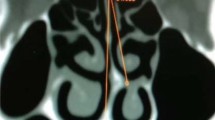Abstract
The present study was aimed to investigate the effects of DNS on the structure of nasal cavity. The paranasal sinus coronal view CT of 108 patients with DNS and 129 hospitalized patients without DNS was retrospectively analyzed. The transverse diameter of nasal cavity (a), transverse diameter of nasal cavity and paranasal sinus (b), angle between maxillary and palatal bone, interalveolar distance, and maxillary rotation distance were measured. The ratio of a/b in experimental group was 0.367 ± 0.006 which was significantly (P = 0.0023) less than that in control group (0.391 ± 0.005). For the angle between maxillary and palatal bone, there was no significant difference found between DNS and control group for both right and left sides. The interalveolar distance was 40.75 mm in experimental group, and 38.8 mm in control (P = 0.0002). For the maxillary rotation distance, findings were considered as significant (P < 0.0001) in experimental group (11.25 mm) compared with control (10.1 mm). The present study demonstrates that long-term DNS affects the development of nasal cavity and paranasal sinus, as well as increases the interalveolar distance and maxillary rotation distance. These influences may be caused by the alteration of airflow inside the nasal cavities.


Similar content being viewed by others
References
Gray L (1967) Deviated nasal septum III—its influence on the physiology and disease of the nose and ear. J Laryngol Otol 81:953–986
Keleş B, Ztürk K, Naldi D, Arbağ H, Zer B (2013) Is there any relationship between nasal septal deviation and concha bullosa
Roblin D, Eccles R (2002) What, if any, is the value of septal surgery? Clin Otolaryngol Allied Sci 27:77–80
Blaugrund SM (1989) Nasal obstruction. The nasal septum and concha bullosa. Otolaryngol Clin North Am 22:291–306
Metson RB, Mardon S (2005) The Harvard Medical School guide to healing your sinuses. McGraw Hill, New York
Kim SK, Heo GE, Seo A, Na Y, Chung S-K (2014) Correlation between nasal airflow characteristics and clinical relevance of nasal septal deviation to nasal airway obstruction. Respir Physiol Neurobiol 192:95–101
Mundra R, Gupta Y, Sinha R, Gupta A (2014) CT scan study of influence of septal angle deviation on lateral nasal wall in patients of chronic rhinosinusitis. Indian J Otolaryngol Head Neck Surg 66:187–190
Lasters F, Mallegho C, Boudewyns A, Vanderveken O, Cox T, Ketelslagers K, Verbraecken J (2014) Nasal symptoms in patients with obstructive sleep apnea and their impact on therapeutic compliance with continuous positive airway pressure. Acta Clin Belg 69:87–91
Foda HM (2005) The role of septal surgery in management of the deviated nose. Plast Reconstr Surg 115:406–415
Bhattacharyya N (2010) The role of CT and MRI in the diagnosis of chronic rhinosinusitis. Curr Allergy Asthma Rep 10:171–174
Cengiz C, Hanifi B, Ercan A, Yasar C (2013) Assessment of the relationship between palatum durum and maxillary bone in patients with nasal polyp, chronic sinusitis or septum deviation. Indian J Otolaryngol Head Neck Surg 65:421–425
Baumann I, Plinkert P (1996) Effect of breathing mode and nose ventilation on growth of the facial bones. HNO 44:229–234
Kim YM, Rha KS, Weissman JD, Hwang PH, Most SP (2011) Correlation of asymmetric facial growth with deviated nasal septum. Laryngoscope 121:1144–1148
Calhoun KH, Rotzler WH, Stiernberg CM (1990) Surgical anatomy of the lateral nasal wall. Otolaryngol Head Neck Surg 102:156–160
Yousem DM, Kennedy D, Rosenberg S (1991) Ostiomeatal complex risk factors for sinusitis: CT evaluation. J Otolaryngol 20:419–424
Cho SH, Kim TH, Kim KR et al (2010) Factors for maxillary sinus volume and craniofacial anatomical features in adults with chronic rhinosinusitis. Arch Otolaryngol Head Neck Surg 136:610–615
Hsu J, Peters AT (2011) Pathophysiology of chronic rhinosinusitis with nasal polyp. Am J Rhinol Allergy 25:285–290
Hamilos DL (2011) Chronic rhinosinusitis: epidemiology and medical management. J Allergy Clin Immunol 128:693–707
Van Crombruggen K, Zhang N, Gevaert P, Tomassen P, Bachert C (2011) Pathogenesis of chronic rhinosinusitis: inflammation. J Allergy Clin Immunol 128:728–732
Serter S, Gunhan K, Can F, Pabuscu Y (2010) Transformation of the maxillary bone in adults with nasal polyposis: a CT morphometric study. Diagn Interv Radiol 16:122–124
Akbay E, Cokkeser Y, Yilmaz O, Cevik C (2013) The relationship between posterior septum deviation and depth of maxillopalatal arch. Auris Nasus Larynx 40:286–290
Bresolin D, Shapiro PA, Shapiro GG, Chapko MK, Dassel S (1983) Mouth breathing in allergic children: its relationship to dentofacial development. Am J Orthod 83:334–340
Acknowledgments
This work was supported by the Fundamental Research Funds for the Central Universities (20620140692), Jiangsu Government Scholarship for Overseas Studies 2014, the Medical Youth Priming Project of Nanjing (QYK11162), the National Natural Science Foundation of China (30973302, 81371090), the Medical Important People Project of Jiangsu Province (RC2007010), and the Medical Important Developing Project of Nanjing (ZKX06019).
Author information
Authors and Affiliations
Corresponding authors
Ethics declarations
Conflict of interest
The authors declare that they have no conflict of interest.
Additional information
J. Wang and X. Dou contributed equally to this work. S. Wang and X. Gao are co-corresponding authors.
Rights and permissions
About this article
Cite this article
Wang, J., Dou, X., Liu, D. et al. Assessment of the effect of deviated nasal septum on the structure of nasal cavity. Eur Arch Otorhinolaryngol 273, 1477–1480 (2016). https://doi.org/10.1007/s00405-015-3770-y
Received:
Accepted:
Published:
Issue Date:
DOI: https://doi.org/10.1007/s00405-015-3770-y




